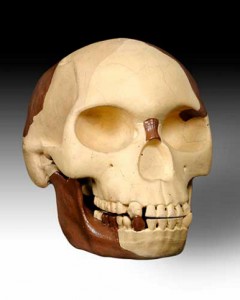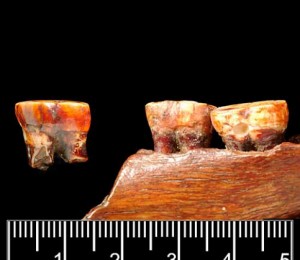Today’s post comes from Morgan Williams, class of 2017 and Art Center Student Docent.
On October 29, 2015, Professor Hiromi Tsuchiya Dollase gave a talk on the Bakemono Sōshi or Monster Scroll in the first lecture of this semester’s Artful Dodger series in the galleries
Tag Archives: pages.vassar.edu
The (so-called) “Missing Link” in Human Evolution!
The “missing link” in human evolution? Well, that’s what English archaeologists believed for many years had been discovered when a skull with both human and ape characteristics was revealed by an amateur archaeologist, Charles Dawson. Unfortunately, for decades this hoax would confuse scientists’ insight into the course of human evolution.
In 1912, Dawson announced that he had pieced together parts of a skull found near Piltdown village; while it had an ape-like jaw and teeth, the brain cavity of the skull was large, similar in size to that of a modern human. This seemed to fit perfectly with the idea of humankind’s intelligence pushing forward its evolution. In addition to the skull, the Piltdown site produced animal bones and primitive tools (as well as an artifact that looked suspiciously like a cricket bat), adding to its apparent validity. Many years after Dawson’s death however, scientists working at the Natural History Museum in London proved that the skull was faked; not only were the bones more recent than initially believe, but while the skull fragments were human, the jaw bone had probably belonged to an orangutan. These scientists also found scrape marks on the teeth, suggesting that someone had filed the teeth to give them a more human appearance.
The trust in this hoax created a false understanding of human evolution, demonstrating the danger of fraudulent archaeology. British scientists may have been particularly accepting of the new discovery, since they had not yet found any significant prehistoric human remains, unlike their European counterparts; not only that, the new discovery seemed the closest link to modern man yet. Their belief was strong enough that when a scientist in Africa discovered a radically different early human skull, some scientists failed to acknowledge that true step on humankind’s evolutionary path. Until the skull was proved a fake in 1949, this hoax represented one of the biggest anomalies of the evolutionary sequence, hindering scientists trying to comprehend humankind’s past.
Perhaps one of the most interesting parts of this entire story is that the true perpetrator or perpetrators of this hoax have never been definitively identified. Dawson almost certainly was involved, as many of his other “discoveries” have also since been proven fraudulent; however, any number of other leading scientists and philosophers may have had a hand in the deception. Regardless of whether their intentions where to deceive or merely to play a practical joke on the scientific community, this hoax shaped and disrupted understanding of human evolution for nearly forty years, signifying the true menace of archaeological hoaxes.
Bibliography
http://www.britannica.com/topic/Piltdown-man
http://www.bbc.co.uk/history/ancient/archaeology/piltdown_man_01.shtml
Image Credits
Piltdown Skull: http://piclib.nhm.ac.uk/results.asp?image=039916&itemw=4&itemf=0001&itemstep=1&itemx=2
Piltdown Man’s Jaw and Teeth: http://piclib.nhm.ac.uk/results.asp?image=040480&itemw=4&itemf=0001&itemstep=1&itemx=22
Interesting Links
This link contains details on a number of the suspects, including Dawson and Arthur Conan Doyle: http://www.theguardian.com/science/2012/feb/05/piltdown-man-archaeologys-greatest-hoax
A somewhat over-dramatic BBC documentary about the Piltdown Man, focusing primarily on the later discovery of the fraud: https://www.youtube.com/watch?v=dOn97lU21L4
International Profile – Ruoyu (Lucy) Li
Ruoyu Li, Class of 2019
Today we bring to you the coolest fresh(wo)man apprentice from OIS!
Ruoyu (Lucy) Li, Class of 2019
Beijing, China
Undecided, but interest in Art History
Hello Ruoyu! International kids often have cool names; can you tell us how you got yours?
Li is my family name and “ruo” means appear to look like, and “yu” means sunlight. So “Ruoyu” means someone who looks like sunlight
Easy Beef Chili recipe
Ingredients (for 4 people)
Butter/Oil
picture from marmiton.org
2 onions
3 cloves of garlic
500-700g of ground beef
1 tb chili powder
2 tb cumin powder
optional: 1 tb (or more if you like to eat spicy!) cayenne pepper or chili flakes
~80g tomato past
1-2 tins of red or black bean
1 beef stock cube
salt & pepper
Directions
In a large pot on medium/high heat, cook the onions and garlic in the oil or butter
The Ethics of Excavation
The excavation and analysis of human remains has long been a staple in archaeology. Archaeologists can learn a lot about a civilization from the remains that they have left and how they take care of their remains. You can tell a lot about the values of a civilization based on their burial rituals and treatment of their own remains. And through the use of forensic archaeology, human remains can be used to give insight into more recent events. With forensic archaeology, more recent remains can be used as evidence in criminal cases. Although the use of excavated remains is a fundamental part of archaeology, and has provided a great deal of information to archaeologist it does not come without controversy. Many people object to the excavation of remains because it does not show respect to the person who died.

Remains of Army Discovered in bog. Gave Archaeologists Information about Teutonic Massacre. Use of Human Remains
Forensic Archaeology is a subset of archaeology that uses artifacts in order to help solve criminal cases. In forensic archaeology, human remains are very important. Archaeologists utilize human remains to determine information about a deceased person from before the person dies. This information age, sex, time of death, method of death, etc. can be crucial to a criminal case. In many cases criminals would have gotten away without being caught without the use of forensic anthropology. But does the good that comes from the use of human remains outweigh the negatives? Some say no.
Since the first excavations of human remains have been conducted there has been controversy. In many cultures, people are taught to show respect to the dead. It is disrespectful to disturb the remains of an already buried person. This can be trouble for archaeologists who need to use human remains to gather information about things. There have been many instances of clashes between archaeologists and people who believe that the use of human remains is wrong. This has occurred many times pertaining to the excavation of ruins belonging to indigenous peoples. Many descendants of Native American tribes are against the excavation of burial sites. A recent example of archaeologists clashing with people who oppose the use of human remains occurred in Britain. People have called for the reburial of the body of a young girl whose body had been excavated 80 years ago to pay respect to the girl. Archaeologists argue that the body is needed to conduct research.
In the end there are both positives and negatives to excavating human remains. The information obtained from human remains gives us great insight into events in both the past and the present, but it is also very controversial. I believe that if the correct respect is given when excavating the remains, that the use of human remains is fine and is an integral part to archaeological discoveries.
Sources:
http://www.bajr.org/BAJRGuides/14.%20Field%20Guide%20to%20the%20Excavation%20of%20Human%20Inhumated%20Remains/FieldGuidetotheExcavationofHumanInhumatedRemains.pdf
http://www.gazetteandherald.co.uk/search/4083964.Decision_to_come_on_girl___s_skeleton/
Further Reading:
http://alunsalt.com/2009/02/01/the-ethics-of-studying-human-remains/
http://www.bbc.com/news/uk-northern-ireland-11426538



